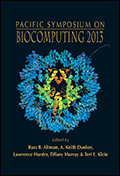Using BioBin to Explore Rare Variant Population Stratification
Carrie B. Moore1, John R. Wallace2, Alex T. Frase3, Sarah A. Pendergrass4, Marylyn D. Ritchie5
1Center for Human Genetics Research, Vanderbilt University;2Center for Systems Genomics, Pennsylvania State University;3Center for Systems Genomics, Pennsylvania State University;4Center for Systems Genomics, Pennsylvania State University;5Center for Systems Genomics, Pennsylvania State University
Email: carrie.c.buchanan@vanderbilt.edu
Pacific Symposium on Biocomputing 18:332-343(2013)

Abstract
Rare variants (RVs) will likely explain additional heritability of many common complex diseases; however, the natural frequencies of rare variation across and between human populations are largely unknown. We have developed a powerful, flexible collapsing method called BioBin that utilizes prior biological knowledge using multiple publicly available database sources to direct analyses. Variants can be collapsed according to functional regions, evolutionary conserved regions, regulatory regions, genes, and/or pathways without the need for external files. We conducted an extensive comparison of rare variant burden differences (MAF < 0.03) between two ancestry groups from 1000 Genomes Project data, Yoruba (YRI) and European descent (CEU) individuals. We found that 56.86% of gene bins, 72.73% of intergenic bins, 69.45% of pathway bins, 32.36% of ORegAnno annotated bins, and 9.10% of evolutionary conserved regions (shared with primates) have statistically significant differences in RV burden. Ongoing efforts include examining additional regional characteristics using regulatory regions and protein binding domains. Our results show interesting variant differences between two ancestral populations and demonstrate that population stratification is a pervasive concern for sequence analyses.
[Full-Text PDF] [PSB Home Page]